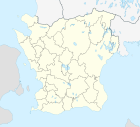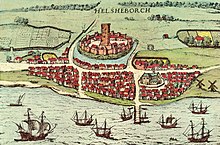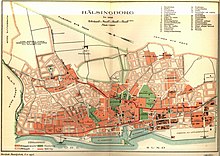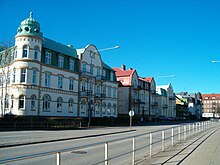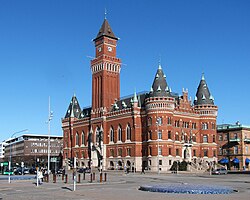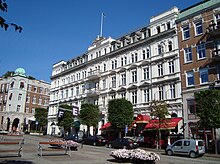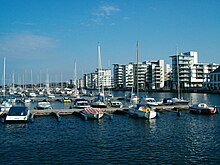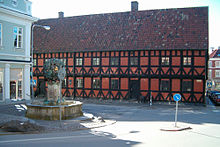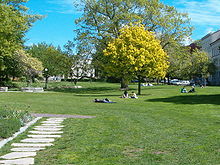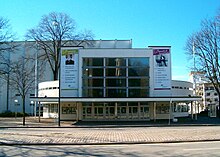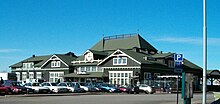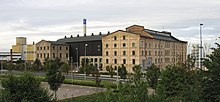Helsingborg
| Helsingborg | ||||
|
||||
| State : | Sweden | |||
| Province (län): | Skåne County | |||
| Historical Province (landskap): | Gentle | |||
| Municipality : | Helsingborg | |||
| Coordinates : | 56 ° 3 ' N , 12 ° 42' E | |||
| SCB code : | 3452 | |||
| Status: | Crime scene | |||
| Residents : | 104,250 (December 31, 2015) | |||
| Area : | 39.57 km² | |||
| Population density : | 2635 inhabitants / km² | |||
| Height : | 10 m ö.h. | |||
| Postal code : | 250 02 - 259 99 | |||
| List of perpetrators in Skåne County | ||||

Helsingborg [ hɛlsiŋbɔrj ] (historically Hälsingborg ; high German outdated Helsingborg Castle ) is a town in southern Sweden, Skåne province County Skåne . It has 104,250 inhabitants (as of December 31, 2015). This makes it the eighth largest city in Sweden and the second largest city in Skåne after Malmö . Helsingborg is the capital of the municipality of the same name . The city is an important industrial location and has the second largest port in the country.
Geography and geology
Helsingborg is located on the west coast of Skåne at the narrowest point of the Öresund , the strait between Sweden and the Danish island of Zealand , opposite the Danish city of Helsingør . In the north, east and south the city is surrounded by open land, which is mainly used for agriculture.
The townscape is characterized by a geological fault zone that stretches slightly inland along the Öresund and divides the town into a higher and a lower part. The fault edge, part of the Tornquist zone , a fault that extends diagonally from the Kattegat through Skåne to Bornholm , and the high plain to the east are called Landborgen . A few natural cuts in the slope, which reaches a height of 20 to 40 meters in the city center, connect the historic old town with the districts above the slope. The old town is wedged between land coves and the Øresund at sea level . The inner city has not expanded inland beyond the natural border drawn by the land caves . Instead, new building land was created in central Helsingborg through land reclamation in the Öresund.
In the south of Helsingborg the river Råån flows into the Öresund.
climate
Due to Helsingborg's location on the Öresund, the city has a cool, temperate climate with an average annual temperature of 8.2 degrees Celsius. The mean monthly temperature in January is -0.1 degrees Celsius, in July 16.8 degrees Celsius. The average annual rainfall is 568 mm.
| Helsingborg | ||||||||||||||||||||||||||||||||||||||||||||||||
|---|---|---|---|---|---|---|---|---|---|---|---|---|---|---|---|---|---|---|---|---|---|---|---|---|---|---|---|---|---|---|---|---|---|---|---|---|---|---|---|---|---|---|---|---|---|---|---|---|
| Climate diagram | ||||||||||||||||||||||||||||||||||||||||||||||||
| ||||||||||||||||||||||||||||||||||||||||||||||||
|
Average monthly temperatures and rainfall for Helsingborg
Source: MSN Weather - Helsingborg, SWE
|
|||||||||||||||||||||||||||||||||||||||||||||||||||||||||||||||||||||||||||
Origin of name
The city name is probably derived from hals for "neck", a name for the narrowest part of the Oresund, "ing" for "people, entourage, residents" and borg for "castle". After a spelling reform in 1906 the name was in 1912 in H ä lsingborg changed to match the new spelling rules. This change was reversed in 1971 as part of a municipal reform.
history
Helsingborg, originally a Danish city, is one of the oldest cities in today's Sweden and has been contested time and again because of its strategic location on the Øresund . The settlement was first mentioned in a letter from Adam von Bremen around 1070 ; However, today the first written mention under the name Helsingaburgh by the Danish King Canute IV on May 21, 1085 is considered the hour of birth of the city.
It is believed that there was a small fortification here at the end of the 9th century to protect the crossing between Skåne and Zealand . The three churches of St. Clemens, St. Petri and St. Olai were among the first larger buildings in the vicinity of the castle. The simple fortress was replaced in the 12th century by a castle made of sandstone, the dominant part of which was a round tower with walls about four meters thick. The city grew and more and more people settled on the banks of the Oresund under the protection of the castle.
Helsingborg was one of the most important cities in Denmark in the 14th century. With its defense tower built around this time, known as Kärnan , the castle was one of the strongest fortresses in Northern Europe. The newly built St. Mary's Church , one of the largest city churches in Denmark in this period, testifies to the importance of Helsingborg.
In 1329 the Danish King Christoph II pledged Helsingborg - like all of Skåne and Blekinge - to Count Johann III. from Holstein-Kiel . Magnus of Norway and Sweden bought the pledge from him in 1332 .
After acquiring the pledge, Magnus asserted sovereignty over Blekinge and Skåne and received homage as King of Skåne and Blekinge. Blekinge and Skåne, and thus Helsingborg, came into a personal union with Norway and Sweden. The sovereignty of Magnus was recognized by Waldemar IV. Atterdag of Denmark in 1343 , but never by the Pope. Waldemar took back Scania and Blekinge in 1360.
In 1369, the troops of the Cologne Confederation, under the command of the Lübeck mayor Bruno von Warendorp , conquered the Helsingör fortress. The assumption of this strategic key position on the Sund was a prerequisite for the end of the Second Waldemark War between the Hanseatic League and Denmark through the Peace of Stralsund in 1370.
Despite the introduction of the Sound Customs in 1429, Helsingborg's importance declined in the 15th and 16th centuries after the more modern fortress Kronborg Castle was built in Helsingør on the opposite side of the Sound . In the 17th and 18th centuries the fate of the city was determined by the devastation caused by the Danish-Swedish wars, which often forced the population to flee.
The city came under the Swedish crown through the Peace of Roskilde in 1658 . During the Skåne War between 1675 and 1679, Helsingborg was recaptured from Denmark twice. For this reason, the Swedish King Charles XI. the demolition of the city walls and most of the castle. Only the Kärnan tower remained. In the course of the Great Northern War , a strong Danish army under Christian Detlev von Reventlow landed south of Helsingborg in 1709 and took the city. The Swedish governor general of Skåne, Magnus Stenbock , defeated the Danish army at the Battle of Helsingborg on February 28, 1710 , and the city was ruled again by the Swedish crown. In 1719 Helsingborg became part of Sweden, like all of Skåne.
The many wars were devastating for the city's population. Epidemics and the severely restricted trade across the Øresund during wartime resulted in stagnation in the population and economic development. In 1711 the plague broke out, which was overcome a year later.
It was only in the second half of the 19th century that the city slowly began to recover. Above all, many new industrial establishments and the abolition of the so-called Sundzolls for the passage of the Øresund in 1857 led to strong population growth. In 1884 Helsingborg had 14,279 inhabitants. In 1892, the first ferry service to Helsingør with steamers started operations. The port became important for the export of grain and other goods. Several industrialists, who often held offices in the municipality or in the Swedish parliament at the same time , drove the development of the city forward.
At the turn of the century, the city expanded rapidly and grew together with formerly independent localities that now belonged to a city that had more than 50,000 inhabitants in the 1920s, making it Sweden's fifth largest city. In 1903 a tram network was inaugurated as part of the so-called " Helsingborg Exhibition " in 1903, which existed until 1967.
In World War II the Germans by the Swedish government introduced 1940-1943 conceded supply line (permittenttågen) of the Wehrmacht on the Russian front in Finland and to occupied Norway by Helsingborg. After the dissolution of the contract and the persecution of the Jewish population in Denmark, among others, hundreds of people fled night after night across the Oresund in 1943 and sought refuge in Helsingborg.
City structure
The city of Helsingborg is made up of 32 of the 42 municipal districts (b-områden) of Helsingborg municipality , which form the “inner district” (innerområde) of the municipality. A city district is named after one of the districts it comprises. Especially on the outskirts, surrounding industrial areas as well as large forest and agricultural areas are part of a city district.
The characters of the individual districts are very different. There is the historic old town (Gamla stan) with buildings that are sometimes several centuries old, mass housing estates on the outskirts of the city such as Drottninghög , which were built in the 1960s and 70s as part of the so-called million dollar program , a nationwide housing project by the Swedish government Villa areas like Olympia from the city's economic heyday and more rural areas like in Råå .
| The boroughs of Helsingborg (classification and number of inhabitants as of January 1, 2006) | ||||||
|---|---|---|---|---|---|---|
| 1 | Norr (3600) | 12 | Center (3347) | 22nd | Narlunda (1125) |

|
| 2 | Mariastaden (2302) | 13 | Eneborg (3816) | 23 | Eskilsminne (1835) | |
| 3 | Ringstorp (2802) | 14th | Wilson Park (1988) | 24 | Gustavslund (2772) | |
| 4th | Berga (1720) | 15th | Rose Garden (4388) | 25th | Planteringen (2663) | |
| 5 | Drottninghög (2708) | 16 | Husensjö (1564) | 26th | Elineberg (2115) | |
| 6th | Dalhem (4530) | 17th | Sofieberg (1606) | 27 | Ramlösa (4593) | |
| 7 * | Tågaborg (7113) | 18th | Adolfsberg (4319) | 28 | Miatorp (2406) | |
| 8th | Stattena (2549) | 19th | Soder (3665) | 29 | Högasten (1034) | |
| 9 | Fredriksdal (4202) | 20th | Högaborg (4017) | 30th | Ättekulla (3274) | |
| 10 | Slottshöjden (3621) | 21st | Folding jaws (930) | 31 | Råå (3021) | |
| 11 | Olympia (1843) | * Tågaborg N (7a) and Tågaborg S (7b) districts are combined here, as they together make up one district. | ||||
population
Development of the population
Until about 1800 Helsingborg had less than 1500 inhabitants. In the second half of the 19th century and the beginning of the 20th century, the population increased by leaps and bounds, which was mainly due to the booming economy at that time and the incorporation of smaller surrounding towns.
The following overview shows the population of Helsingborg from 1570 to 2005. The information relates to the city of Helsingborg ( s ) before 1862 , from 1862 to 1970 to the municipality of Helsingborg ( g ) and from 1971 to the inner district (innerområde) the municipality of Helsingborg ( i ) .
| year | Residents | reference |
|---|---|---|
| 1570 | 659 | s |
| 1610 | 754 | s |
| 1650 | 978 | s |
| 1690 | 1,287 | s |
| 1730 | 1,269 | s |
| 1770 | 1,321 | s |
| 1810 | 2,087 | s |
| 1850 | 4.140 | s |
| 1890 | 20,410 | G |
| 1930 | 55,889 | G |
| 1950 | 71,627 | G |
| 1970 | 82,432 | G |
| 1995 | 84,494 | i |
| December 31, 2000 | 87.908 | i |
| December 31, 2001 | 88,616 | i |
| December 31, 2002 | 89,393 | i |
| December 31, 2003 | 89.955 | i |
| December 31, 2004 | 90,768 | i |
| December 31, 2005 | 91,468 | i |
| December 31, 2010 | 97.122 | i |
| December 31, 2015 | 104,250 | i |
Population with a foreign background
The proportion of the population with a foreign background in the total population in Helsingborg is 23.2 percent. "Population with a foreign background" is to be understood as meaning the residents who were either born abroad or whose parents were both born abroad.
The most important countries of origin for those born abroad, there are around 150 nations in total, and the table shows the number of people who came from there for 2006. The figures refer to Helsingborg municipality ; However, conclusions can be drawn about the situation in the city of Helsingborg, as around 84.5 percent of the community's foreign population live in the city.
| Country of origin | Number of people |
|---|---|
| Yugoslavia | 3111 |
| Denmark | 2258 |
| Bosnia and Herzegovina | 1474 |
| Poland | 1387 |
| Iraq | 1171 |
| Lebanon | 1016 |
| Finland | 860 |
| Germany | 785 |
| Iran | 689 |
| Vietnam | 510 |
| Romania | 434 |
| Hungary | 387 |
| Norway | 385 |
| Turkey | 309 |
| Rest | 5494 |
religion
Since no data on religious affiliation may be collected in Sweden and therefore no official statistics exist, one can only make assumptions in this regard.
The largest religious group are the members of the Evangelical Lutheran Church of Sweden , which was a state church until 1999. According to its own information, it counted on November 1, 2005 in the four communities ( församlingar ) Maria, Filborna, Gustaf Adolf and Raus, which are located in the city, 62,747 members. Since January 1, 1990, the store, the Serbian Orthodox Church in Helsingborg, has been represented by the parish of St. Basilus . The parish responsible for north-west Skåne has had its own church building since 1996 . There are also several free church congregations, including the Church of Jesus Christ of Latter-day Saints , the Pentecostal Movement , the Evangelical Fatherland Foundation and the Swedish Mission Church .
In addition to the Christian denominations, there is a Jewish community with a synagogue in the center of Helsingborg. The Ahel-Al-Sunnah Association is the largest Islamic association in Helsingborg and has its meeting rooms in the Högasten district .
Social structure
There are traditionally significant differences in social structure between the central districts north and south of the center . While the southern parts of the city used to be the residential areas of the workers employed in the neighboring industrial areas and the northern parts of the city the home of the better-off citizens, today there are significant differences between the south with parts of town like Söder , Planteringen and Högaborg and the north with parts of town like Norr and Tågaborg for proportion of foreigners , unemployment rate , income distribution and level of education .
The areas with a predominantly socially disadvantaged population include many of the districts that were created as part of the million-dollar program , such as Drottninghög in the northeast of the city.
The differences can be demonstrated on the basis of the above-mentioned statistical characteristics, the proportion of foreigners, the unemployment rate, the level of education (using the example of the proportion of the population with a post-high school diploma) and the average annual income:
The results of a study by the Swedish Integrationsverket show that segregation in Helsingborg increased further between 1997 and 2004.
politics
Main article: Helsingborg (politics)
The administrative authority of the city is the Helsingborg Municipality (Helsingborgs stad) . However, their area extends beyond the boundaries of the actual city in terms of settlement geography ( Tatort ) and includes outlying localities.
Helsingborg is the main town (centralort) of the municipality and thus the seat of the municipal administration.
Helsingborg is traditionally shaped by social democracy. Since the last municipal elections in 2006, municipal politics has been largely determined by the so-called “civil alliance” made up of conservatives , Christian democrats , the center and the liberals .
Historical development
In 1862, when municipal laws came into force, Helsingborg was transformed into a borough where all taxpayers to the city had the right to elect the city council. Previously this was the citizens that the state of the citizens (burskap) were reserved. The new township was headed by a magistrate and had a 26-member town council (stadsfullmäktige) . Half of the municipal council was elected every other year for four years. Since there were no parties at that time and thus few contradicting political debates, the population's interest in the elections was initially low. The electoral system provided that each resident could have up to 100 votes, depending on how much taxes he paid to the community. The maximum number of votes was lowered to 40 in 1909 and this form of electoral system was abolished in 1918. In 1899 the first social democrat was elected to the local council. This happened on the initiative of the entrepreneur Nils Persson and the Reichstag member Oscar Trapp , who consider it important that the labor movement had a say in the local council. The 1909 electoral reform tripled the proportion of Social Democrats in the local council and in 1918 they became the largest parliamentary group.
In 1905, 1907, 1917 and 1918 many places in the rural parishes surrounding the city were incorporated into Helsingborg Municipality. In 1971, the municipality of Helsingborg was merged with four rural municipalities formed in the previous municipal reform of 1952 and has been part of the municipality of Helsingborg ever since . The parish is one of thirteen in the country that uses stad instead of commun in the proper name .
|
|
|
|
|
For the history of the Helsingborg municipality from 1971 see: Helsingborg (municipality)
coat of arms
The Helsingborg city coat of arms is a further development of a seal from the 14th century. The seal shows a castle with a central tower crowned by a cross with a pointed roof behind a wall with battlements. The tower probably represents a church tower. The older interpretation that it is the Kärnan tower is improbable . According to recent archaeological findings, this tower is younger than the seal. The seal was recognized as a coat of arms by King Gustav V twice, in 1916 and 1946 . The coat of arms has been used by the Helsingborg municipality since 1971 . It was registered for the municipality at the Swedish Patent Office in 1974 .
Town twinning
Helsingborg was one of the first cities in the world, a city partnership came in. The cooperation with the Danish Helsingør began as early as 1838. In 1849 representatives of both cities met on the frozen Öresund to sign a declaration of friendship. After the decision to build the Øresund connection between Malmö and Copenhagen and in view of the resulting loss of the shortest connection between Sweden and Denmark and the relocation of the main traffic routes to the south, representatives of the two cities signed a cooperation agreement ("HH-samarbetet") in 1995 Business, tourism, transport infrastructure, environment, culture and education.
Today Helsingborg has four twin cities (vänorter) :
-
 Helsingør ( Denmark ), since 1849
Helsingør ( Denmark ), since 1849 -
 Pärnu ( Estonia )
Pärnu ( Estonia ) -
 Dubrovnik ( Croatia ), since 1998
Dubrovnik ( Croatia ), since 1998 -
 Alexandria, VA ( USA )
Alexandria, VA ( USA )
In addition to the city partnerships mentioned above, there are numerous other partnerships between schools in Helsingborg and other schools around the world. For example, there has been an annual student exchange between a grammar school in Helsingborg and the Campe grammar school in Holzminden (Lower Saxony) for many years .
Cityscape
Despite the old age of the city, there are few buildings that testify to it. Most of the old buildings fell victim to the devastation caused by the wars between Danes and Swedes that broke out over the centuries. The destruction was particularly bad in the Skåne War , when the Danish King Kristian V had large parts of Helsingborg torn down in order to strengthen the city fortifications with the material obtained. Charles XI. destroyed Helsingborg Castle, of which only the Kärnan tower remained. The only secular buildings from the 17th and 18th centuries that survived the centuries are the Jacob Hansen House (Jacob Hansens hus) , the Gamlegård and the Henckelsche Hof (Henckelska gården) .
In the 19th century Helsingborg developed into a "divided" city with the rich northern parts of the city and the poorer workers' quarters in the south. The traditional border was Trädgårdsgatan . This division is still visible today, as the southern district of Söder has the highest density of immigrants. The reasons for this separation of the population are both the proximity of the southern districts to the industrial areas and the fact that the north was the more attractive residential area due to its direct access to the water, which was denied to the residential areas in the south by the port and the railway.
Building history
The first houses in the city were on the hillside under the protection of the castle. The city then continued to grow towards Öresund. In the areas adjoining the Kärnan tower, a medieval street pattern with irregular residential areas can still be seen. Here is Helsingborg's first main street, Storgatan , which is now divided into a northern and a southern part. On this street are some of the most historically valuable buildings in the city. These include the St. Mary's Church and Helsingborg's oldest residential building, the Jacob Hansen House, which is the only one in the city that dates from before 1670.
Until the middle of the 19th century, mainly half-timbered houses were built. When the city began to flourish, many of the old buildings were replaced by more ostentatious architecture. With the establishment of the central port in 1832, the place grew into the Øresund. On the newly reclaimed land, many splendid buildings were built along the parade streets Drottninggatan and Järnvägsgatan , today's main traffic axis, as well as the central square Stortorget , including the Hotel Mollberg and the neo-Gothic town hall, built in 1897, as a sign of the increased importance of the City should apply.
The main train station was built on Järnvägsgatan in 1865, and together with the port, it formed the basis for many new industrial operations. Subsequent to these operations, workers' quarters were created, which together formed the Söder district. The Gustav Adolf Church and the Nya torg square (now called Gustaf Adolfs torg ) were built here as the second city center.
In the 19th century the fortifications east of the castle were demolished. Buildings for various institutions such as the commercial high school from 1863, the military hospital from 1878, the poor care station from 1888 and the Nicolaischule from 1898 were built here. With these buildings, the Olympia district established itself with villas in Art Nouveau style . With the help of a donation from the industrialist Henry Dunker , the city was able to start a competition for a new concert hall in 1927. The architect Sven Markelius won this competition. His winning proposal was a functional building with white plaster that was completed in 1932 and is now the best example of functional architecture in Sweden.
Due to the constant expansion of Helsingborg, all architectural styles of the last two centuries are represented in the city. The Swedish million program has left its mark here in the districts of Dalhem, Fredriksdal and Adolfsberg. Helsingborg was also not spared the great wave of demolitions of the 1970s. Many older buildings in the center had to give way to new brick buildings. Two of these modern buildings are the Skandia company building and the SEB bank .
The largest construction project in recent times are the buildings that were erected in 1999 for the architecture exhibition H99 at the Nordhafen in the new functional style.
Places
Helsingborg's oldest square is called Stortorget and stretches from a staircase in the east to Drottninggatan (Konsul Trapps plats) in the west, where there is an equestrian statue of Magnus Stenbock . The square owes its special elongated shape to the fact that Danish troops in the Scandinavian War (1676–1679) cut a wide supply corridor between the castle and the port through the city. After the war ended, the open space was used for trading purposes until the end of the 19th century. In the course of time, large buildings with magnificent facades were built around the square.
Further towards the port is Hamntorget Square , which was created in the 1890s in connection with the construction of the northern port. Used as a parking lot in everyday life, it is used for concerts on special occasions such as the Helsingborg Festival. On the square is the old customs house (Gamla tullhuset) , today the departure of Öresund ferries , and the old ferry station, now a rock club. The statue of Sjöfartsgudinnan ("seafaring goddess"), which was created by Carl Milles , stands directly on the pier . Next to it is a monument that commemorates the landing of Karl XIV Johans in Helsingborg.
Between Hamntorget and Knutpunkte , the (bus) train station and ferry terminal, lies Kungstorget , which used to be a train and park area when the train tracks still ran across the city. Today there are outdoor restaurants and stages for various events here in summer.
The Sundstorget was created on the Sound abgewonnenem country. 1865 Several monumental buildings were built around the square and later a large part of the market trade was moved here from Stortorget after a market hall had been built in the western half of the square. In the second half of the 20th century, this was demolished and the square was used as a parking lot. In 2004, during renovation work, the cars were banned underground. A new market hall made of glass was built in the south of the square. There are several restaurants with terraces along the north side of the square. In the west the square is bounded by Dunkers kulturhus .
Some places bear the names of people who were important to the development of the city. Examples are Henry Dunkers plats between the Konzerthaus (Konserthuset) and the Stadttheater (Stadsteatern) , which was named during the H99 architecture exhibition to honor Dunker's services to the city's cultural life. Konsul Olssons plats is surrounded by small alleys in the middle of the old town near a warehouse belonging to the entrepreneur Petter Olsson . Consul Perssons plats is in the Söder district . Nils Persson's sulfuric acid factory once stood here ; since 2005 the square has been dominated by the newly built Tingshuset , the seat of the local court (tingsrätt) . To the north of the square, Mäster Palms plats joins the Söderpunkte department store . A little further south is Gustav Adolfs torg , formerly Nya Torg , which is used as a market place most days of the week.
Parks and green spaces
Many parks are on the edge of the city center and form a green belt. They often have their origins in private gardens that were later donated to the city. Most of the parks were created at the end of the 19th century in connection with Helsingborg's strong expansion. They were intended as a green counterweight to the new buildings and industrial plants.
The first real park was Krookska planteringen , located between the city center and the then new district of Söder. When the intention was to develop the open space, the Krook siblings bought the site and donated it to the city on condition that it be turned into a park. In 1873 the park, which is now commonly referred to as Stadtpark (Stadsparken) , was completed.
Another early park is the Öresundpark, which was created in 1877 along a natural cut in the landborgen when the watermills located in the city's oldest industrial area were moved to the new industrial area in the south. The main access road to the city center runs through the park from the northeast. The park stretches up to the landborgen plateau . From there the view falls over the Øresund.
On the occasion of the “Helsingborg Exhibition” (Helsingborgsutställningen) in 1903, the former castle grounds around the Kärnan tower , which has only been thinly built on since the fortifications were demolished, was transformed into a park called Slottshagen . Today there is a rose garden and an open-air theater.
The Fredriksdal open-air museum is located in the Olympia district and was donated to the city in 1918 by Gisela Trapp, the widow of the consul Oscar Trapp . The park is home to Fredriksdals herrgård , a botanical garden , a garden with fruit trees and the Fredriksdal theater.
After the death of King Gustav VI. Adolfs Helsingborg received Sofiero Castle north of the city as a gift. The associated park owes its fame to the many rhododendron species growing there as well as events such as orchid competitions and classic car exhibitions .
A gift from Ida and Otto Banck in 1912 is the villa and park Vikingsberg in the higher part of Helsingborg. For many years the villa was the home of the municipal art collection. Today there is a private art gallery here.
Another well-known park is the Ramlösa Fountain Park (Ramlösa brunnspark) in the south of Helsingborg. The old Ramlösa spring, which was put into operation in 1707, was located here, and here was the place where spa guests cured their ailments with medicinal water in the 18th and 19th centuries. In the park there are some yellow-painted wooden houses decorated with sawmills.
In the north of the city lies the Pålsjö forest (Pålsjö skog) in the vicinity of Pålsjö Castle and the associated castle park. In the south lies the nature reserve Rååns dalgång , which is bordered on one side by the river Råån. On the edge is the Raus Church (Raus kyrka) , the oldest church in Helsingborg, the history of which goes back to the 12th century.
Along the edge of land borrow was country Borg Promenade created, the more parks of the city of Pålsjö Skog to Råådalen by a trail links from which a view of the Sound is.
Culture, sights and leisure
Helsingborg has a wide range of cultural and leisure facilities. The city administration often supports them with financial means. With the establishment of the Kulturhaus (Dunkers kulturhus) Helsingborg received a central facility for art, music and exhibitions.
theatre
There was a theater in the city as early as 1813 . At that time, the then owner of the medicinal water fountain in Ramlösa, Achates von Platen, was given permission to build a “makeshift wooden theater” on Prästgatan Street . In 1859 the theater was bought by the city and soon voices were heard calling for a new and contemporary theater building. The new theater, which opened in 1877, increasingly attracted traveling theater groups and at the beginning of the 20th century the desire for a permanent ensemble arose. In 1921, the first theater company in Sweden that was firmly connected to a city theater was founded. Due to the higher (especially spatial) requirements that this entailed, the theater quickly became too small and non-functional. The demands of the audience grew. In 1976 the new city theater was built next to the concert hall, which has a large stage called “the big one” (Storan) and a smaller one, consequently called “the small one” (Lillan) . The old theater was torn down in the same year, despite major protests.
Theater performances also take place in Dunkers Kulturhus . In summer, a visit to the Fredriksdal open-air theater, founded in 1932, is popular. It is known nationwide through the broadcast of performances on television and through the longstanding work of the actor Nils Poppe . Revues in the open air can be seen in the Slottshagen Park in summer .
Museums
city Museum
Consul Oscar Trapp , interested in history , proposed the establishment of a museum in Helsingborg at the beginning of the 20th century . In 1909 the new city museum opened in a former school building on Södra Storgatan street . In addition to works of art, it showed collections with scientific , archaeological , ethnographic and cultural-historical topics, some of which had already started in 1890. After Otto Banck donated Villa Vikingsberg to the city, the art collection was able to move there in 1929. Over time, the locations in Södra Storgatan became too small for the remaining exhibitions and alternatives were sought. The question of space could only be resolved in 2002, when both the city museum and the art collection were relocated from Villa Vikingsberg to Dunkers kulturhus . In addition to exhibitions on the history of the city, the city museum now shows graphic sheets, oil paintings, handicrafts and designer furniture, most of which come from the northwestern area of Skåne.
Fredriksdal Open Air Museum
In 1918 Oscar Trapp's widow Gisela Trapp donated the Fredriksdal estate with the associated lands to the museum on the condition that an open-air museum was set up there and that the land should be used to finance the museum operations. The Fredriksdal open-air museum has been expanded over the years to include further historical courtyards from different areas of Skåne and buildings of cultural and historical interest from Helsingborg's old quarters. In one of the old houses in the city is the Grafiska museet - the largest of its kind in Sweden - which shows the history of printing from Gutenberg's time to the present day. Adjacent to Fredriksdal is the “Kulturlager” (Kulturmagasinet) , where large parts of the comprehensive collections of Helsingborg museums are (temporarily) stored. The Kulturmagasinet is also the owner of the Kärnan castle tower and is therefore responsible for its maintenance.
Other museums
To the east of the Kärnan there are two other museums - the School Museum (Skolmuseet ) and the Medical History Museum (Medicinhistoriska museet) . The school museum was established in 1985 in the old Östra skolan next to the Slottsvångschule. It shows restored old school facilities and teaching aids from various elementary schools in and around Helsingborg. The Medical History Museum in a former children's hospital shows historical hospital facilities and objects from the field of care. The Helsingborg Sports Museum (Helsingborgs Idrottsmuseum) on Carl Krooks gata in Söder provides an insight into Helsingborg's long sports history and awards the Helsingborg Sportsman of the Year award (Årets idrottare i Helsingborg) . Outside the city is the “Standby Museum”, which in the Helsingborg underground battery (Batteri Helsingborg) , built in 1940, tells of the circumstances in Sweden during the Second World War and shows war material from that time. In "Kulturhotell" a "Museum of Failure" opened in June 2017; it shows around 70 failed and unsuccessful inventions. Samuel West is the founder and director.
music
Until well into the 19th century, a concert was a rather unusual event in the city on the Øresund. Only a few ensembles played now and then at the city's mineral springs, the Sofienquelle (Sofiakällan) and the Ramlösa spring , and the choir Husarrengementets musikkår gave occasional public concerts. The Helsingborgs musiksällskap (Helsingborgs musiksällskap) was founded in 1896 in order to awaken and promote the love of music among the Helsingborg citizens with regular concerts. In 1911 the Swedish Reichstag decided to support orchestras in Sweden's provincial cities. Since the city also participated in the funding measures, the orchestral association Nordwestliches Schonen (Nordvästra Skånes Orkesterförening) was established in the same year , from which the Helsingborg Symphony Orchestra later emerged. The great interest that the new facility met with in the first few years soon threatened to wane as there was no permanent concert hall . In 1932 the new house finally stood. Helsingborgs konserthus , designed by the architect Sven Markelius , ensured a significantly increasing interest in music in the city.
The cultural life in Helsingborg today can rely on a wide range of music from all genres - from classical to jazz to more modern music. In addition to regular performances by the Helsingborg Symphony Orchestra, many guest appearances take place in the concert hall. Dunkers kulturhus is a well-known location for concerts on a smaller scale, for example for performances by the music school . In the churches of the city, especially in the Marienkirche and the Gustav-Adolf-Kirche, various musical events such as Taizé masses or solo concerts are often held . Lovers of lively music are in the right place in the basement of the jazz club on Kullegatan Street . The Tivoli am Nordhafen is the city's only rock club and offers regular concerts by popular groups. There are also various music groups in Helsingborg, including the Helsingborg Chamber Choir (Helsingborgs kammarkör) , the Helsingborg Chamber Music Association (Helsingborgs kammarmusikförening) , Visans vänner (“Friends of the Wise”), Pearls of the Sound and the Helsingborg vocal ensemble (Helsingborgs vocal ensemble ) .
Buildings
One of Helsingborg's “outstanding” sights is the restored Kärnan castle tower , the only remaining part of the Helsingborg medieval fortification, which was built in 1150 and razed in 1680 . From there, the view goes over the Øresund towards Denmark. The town hall , built in 1857, and the staircase at Stortorget as well as the St. Mary's Church from the 12th century are worth seeing .
The Brunnenhotel Ramlösa ( Ramlösa brunnshotell , also Stora hotellet , "Big Hotel"), built between 1876 and 1882 in the Ramlösa district, which is mainly known for the mineral water extracted here, is the largest Scandinavian building made of wood. The surrounding park-like residential area has long been a meeting place for the social upper class of Skåne. Around 3 km north of the city is Sofiero Castle , which is surrounded by parks and the former summer residence of the royal family. The Fredriksdal open-air theater in the Fredriksdal open-air museum is known throughout the country .
Gastronomy and night life
Helsingborg has a number of popular restaurants and one of the highest density of bars in Sweden.
After all, three out of twenty restaurants of the “Swedish master class” can be found in Helsingborg, according to the restaurant guide “White Guide 2006”. In addition to other good and popular addresses of more recent date, there are some restaurants that can look back on a long tradition and are popular, above all Mollbergs matsalar (for example "Mollbergs Speisesäle "), which are attached to the Hotel Mollberg . There has been a restaurant here since the 15th century. Due to Helsingborg's location on the Öresund, there are a number of restaurants along the waterfront in the area of the north harbor, the Kaipromenade (kay promenades) and the beach promenade (beach promenades) , which serve in the open air in summer. There are also a variety of restaurants with dishes from all over the world. Some pastry shops and cafés , some with a history dating back more than a hundred years, can be found in Helsingborg. As is common in cities of this size, widespread fast food restaurant and café chains such as McDonald’s and Wayne’s Coffee have branches in the city.
Night clubs and pubs are concentrated in the city center. The Söder district has a nightlife to offer.
Beach areas
Helsingborg is one of the few cities in Sweden with attractive bathing beaches that are only ten minutes' walk from the center. In the summer, people can often be seen in the city in bathing suits. The closest bathing place to the city is called "Tropical Beach" with palm trees and sun loungers. It was created with the exhibition H99 and is located directly at the port entrance of the Inner Harbor (Inre hamn) .
To the north of the northern harbor (Norra hamn) are the sandless bathing spots called “Järnvägsmännens” and “Gröningen” with a large lawn and bathing jetty. Further north lies the Örestrandsbad ( "Fria bad" called), one of the most popular beaches, such as the far north of the town of "Vikings beach" (Viking beach) , which is wheelchair accessible.
To the south of Helsingborg the shore of the Öresund is quite shallow, which means that the beaches Råå vallar and Örby ängar are preferred by families with small children. Helsingborg's nudist beach , Knähakens bad, is located between these beaches and the harbor area .
There are also three seaside bathing houses (kallbadhus) in Helsingborg , located south of the Viking beach (Pålsjöbaden) , between Örestrandsbad and Gröningen (Norra Kallbadhuset or "Kallis") , and in the south at Råå (Råå kallbadhus) .
Sports
Helsingborg Olympics
Helsingborg can look back on a long sports history. As early as 1834, the first sports festival in the Olympic tradition was held near Ramlösa . The “Olympic Association” (Olympiska föreningen) was behind the Games, the aim of which was to arouse interest in the Olympic Games in Sweden and Norway. The disciplines represented at this Helsingborg Olympics were gymnastics (gymnastik) , running (kapplöpning) , wrestling (brottning) and climbing (klättring) . The games attracted a considerable number of spectators and were repeated once in 1836. Some streets in the area around the venue, today an industrial area around the Ramlösa train station, still bear names such as Kapplöpningsgatan , Fäktmästargatan and Rännarbanan in memory of what happened.
Soccer
The dominant sport in Helsingborg is the game of football and there are a wide variety of football clubs in the city. The most successful of these is Helsingborgs IF (HIF), created in 1907 through the merger of the Svithiod and Stattena clubs. The HIF currently plays in the second highest Swedish league, the Superettan . From the late 1920s to the early 1940s, Helsingborgs IF was one of Sweden's top teams, winning the championship in 1929, 1930, 1933, 1934 and 1941. This was followed by a phase with more modest successes and in 1968 the club finally rose to Division 1 . The resurgence only succeeded in 1992, which was followed by winning the championship title in 1999. The home stadium of the HIF is the Olympia , one of the oldest stadiums in Sweden, built in 1898. Originally built for both football and athletics events, the arena is now a football stadium with seating for around 16,700 spectators. There are numerous other sports facilities in the vicinity of the stadium.
However, the HIF was not always Helsingborg's only representative in Fotbollsallsvenskan. In 1951 and 1952 the Råå IF played there , whose greatest triumph was the victory of the national cup in 1948 . Today the club plays in the amateur field. Other football clubs in the city are Högaborgs BK , the hometown club of Henrik Larsson , founded in 1927 , and Helsingborgs Södra BIS , which was created in 1991 from the amalgamation of Helsingborgs Södra BK , Helsingborgs BoIS and BK Drott , which currently only play at a lower level.
Helsingborg's most successful women's soccer team is part of Stattena IF , founded in 1922. Today it plays in Division 1 after two seasons in the women's Allsvenskan in 2003 and 2004.
IFK Helsingborg
Helsingborgs Sportkameradschaft ( Idrottsföreningen Kamraterna ) , IFK Helsingborg , was founded in 1896 by the 16-year-old Hjalmar Hedenblad as Sällskapet Idrottsvänner ("Society of Sports Friends ") and became a sports comradeship at the same time as it was merged with the GFK football club. In its history, the club has been active in many disciplines such as football, cycling , swimming , orienteering , handball , gymnastics , ice hockey and basketball . Sports represented today are athletics (the only ones that have been involved since the company was founded), skiing , tennis , bowling , figure skating , volleyball and triathlon . The IFK is at home on the Heden sports field and in the “House of Sports”.
Other sports
The "House of Sports" (Idrottens hus) is the largest sports hall in the city. The largest hall holds 1,800 spectators. The house of sports is used by the handball club Olympic / Viking Helsingborg HK , the indoor bandy club FC Helsingborg and the basketball club Helsingborg Pearls for training and home games. The handball club Olympic / Viking emerged in 1994 from its predecessors Olympia and Vikingarna and plays in the Elitserien i handboll för herrar in 2009/2010 , the women in Division 2. The FC Helsingborg, founded in 2003, plays in the Innebandy Eliterie . The basketball club Helsingborg Pearls - with 900 members and 20 youth teams - played since 2003 in the Swedish Basketligan under the name of the main sponsor, Öresundskraft . In Helsingborg, ice hockey is a bit out of the way in the shadow of football.
The city's ice hockey club , HHC Redskins, founded in 1977, plays in Division 2 . The home stadium, Olympiarinken , holds 2100 spectators.
A large number of gymnastics clubs , GF Fram, GF Ling, Helsingborgs Turnéförening and Råå GF, which all belong to Helsingborgs Gymnastikförbund , are located in the "House of Gymnastics" (Gymnastikens Hus) in the south of Helsingborg.
The city's swimming club, Helsingborgs Simsällskap, is one of the most successful in Sweden. The association operates the Filborna swimming pool in the Ättekulla district. The Simhallsbadet swimming pool is located south of the city center .
More recent additions to Helsingborg's sports landscape are rugby (Rugby Club Gripen) and American football (Helsingborg Crocodiles).
Other sports clubs in Helsingborg include the table tennis club BTK Rekord, the running club HLK-92 and the Helsingborg badminton club .
With the BK Borgen , the city has an internationally successful billiards club. Founded in 1974 by Lennart Blomdahl and Frans Frank, it won the Coupe d'Europe four times and was Swedish three- cushion champion for the 30th time in 2012 .
Economy and Infrastructure
economy
Helsingborg has over 10,000 taxable companies registered, 94 of which have more than 50 employees. Around 3,100 companies employ between 2 and 49 people and around 7,000 are one-man companies. The companies offer a total of around 58,000 jobs.
The largest branches of the economy are trade and transport with around 15,000 employees. Other areas of focus are the food , chemical and pharmaceutical industries . The fastest growing is the service sector , which has doubled over the past twenty years.
This information relates to the entire municipality of Helsingborg and allows conclusions to be drawn about the situation in the city, as it is the center of economic activity in the municipality.
Established businesses
Helsingborg's convenient location was and is one reason for the city's good economic climate. Helsingborg and the surrounding area have the most corporate headquarters in Sweden after Stockholm , Gothenburg and Malmö .
Some large, partly internationally known companies that operate in Helsingborg are ABB , the trading company ICA , the furniture company Ikea , the pharmaceutical company Pfizer , SKF Multitec AB , the shoe and tennis ball manufacturer Tretorn , the mineral water manufacturer Ramlösa Hälsobrunn AB and Unilever Bestfoods .
retail trade
When Kullagatan Street was converted into a pedestrian zone in 1961, Helsingborg became Sweden's first pedestrian zone. Today most of the shops in the center are on this street, many of which are branches of the retail chains represented throughout Sweden . The shopping street continues to the south with Mariagatan and Bruksgatans streets . Here and parallel to Kullegatan in Norra and Södra Storgatan , which are not pedestrian zones, there are more and more non-chain retailers.
At Mäster Palms plats in the Söder district is the Söderpunkte shopping center with a number of large chain stores and snack bars . A little further south on Gustav Adolfs torg square there is a market most days of the week .
About six kilometers outside the city is the Väla Shopping Center (Väla centrum) , one of the largest in Sweden with an area of 47,000 square meters and over a hundred shops of various sizes. There is also a department store of the large chains ICA (ICA Maxi) and Coop (Coop Forum) near the city .
Another shopping alternative is Helsingør on the Danish side of the Øresund, which can be reached by ferry from the city center in around twenty minutes. The particular attraction of Helsingør, which attracts many customers from Helsingborg and the surrounding area, lies in the lower prices for spirits in Denmark.
Economic history
Helsingborg's industrial history began at the beginning of the 18th century when the first small factories opened, producing, among other things, tobacco products and textiles. The first larger company was Fayence och porcellains fabrique near Pålsjö in the north of the city, founded in 1766 by Michael Andreas Cöster and closed again in 1774 after economic problems. In 1799, Count Erik Ruuth founded an iron foundry and a ceramics factory on the southern outskirts. Known under the common name Ruuthska bruket , Helsingborg has long been the largest employers.
In the second half of the 19th century, the city experienced a strong economic boom with an explosive increase in the number of start-ups, followed by a similarly strong population growth . This development was mainly thanks to the foresight and entrepreneurship of two people:
One of them was Petter Olsson , a commercial entrepreneur who had made a fortune exporting grain. As a member of the city council , Olsson has been a driving force behind improving the city's transport infrastructure . With his private fortune, he participated in the financing of numerous projects, such as the expansion of the south port (Södra hamnen) in 1880 and the north port (Norra hamnen) twelve years later . He was behind the construction of the railway lines between Helsingborg and Eslöv , Hässleholm , Landskrona and Värnamo , which contributed greatly to the city's economic growth during this period. Olsson's other activities, meanwhile appointed consul , included the founding of numerous industrial companies, including the steam-powered mill Helsingborgs Ångqvarns AB in 1884, the Sockerbruket sugar factory (in whose buildings some units of the Ikea furniture company are now based) in 1890, and Helsingborgs Gummi fabriks AB together with Johan Dunker, father of Henry Dunker and others 1891, and Skånska Jute fabriks AB 1896.
The other person of great importance was Nils Persson , with whom Olsson founded the sugar factory. He was later appointed consul. He began his entrepreneurial career as a trader and importer of artificial fertilizers . He founded Superfosfat - & Svavelsyre fabriks AB in 1874. As a raw material, he imported pyrites from his own mines in Sulitjelma, Norway . Since the mountains in that region were rich in iron ore , his copper processing company Helsingborgs Kopparverk started production in 1886 . In addition, Helsingborgs Ångtegelbruk AB (1873), the aforementioned sugar factory and Helsingborgs Cinderoch Kalbfabriks AB owed their existence to Persson.
Places in the city were later named after both consuls. Consul Olssons plats is located in the north of the city center, Consul Perssons plats in the district of Söder opposite the southern harbor.
Many of the industrial establishments that were founded in the 19th century have survived to this day, but under different names. Thus Ruuthska Bruket in 1869 Helsingborgs Jern- och Lerkärlsfabriks AB renamed and moved as the iron foundry in 1885 by Söder also changed so that her name and her name was now on Helsingborgs Mekaniska Verkstad . In 1918 it was transferred to AB Elektromekano , which later became part of the ASEA group, today's ABB . Persson's sulfuric acid factory became Reymersholms Gamla Industri AB in 1918 , which was bought by the mining company Boliden AB in 1963 . In 1977 this resulted in Boliden Kemi AB , which was finally bought in 1989 by the Finnish chemical company Kemira Oy and is now called Kemira Kemi AB . Helsingborgs Gummifabriks AB is now called Tretorn Sweden AB .
Several shipping companies were founded in Helsingborg in the 19th century . The first shipowners were the brothers Carl August, Otto and Bror Banck, who created C A Banck & Co in 1873 . Consul Olsson was active in the shipping business and, together with the ship broker Axel Pyk and Consul N. C. Corfitzon, was a partner in Rederie AB Helsingborg (1896). At the beginning of the 20th century, more shipping companies were established and when the Second World War broke out there were around 50 shipping companies in Helsingborg. The largest among them were Transmarin , Gorthons and Hillerströms . In the 1970s and 1980s, many shipowners ran into economic difficulties, which meant that today not a single company in the industry is based in the city.
traffic
Helsingborg is an important transport hub in the Öresund region and has connections to the Swedish and indirectly to the Danish road and rail network. The city can also be reached by sea and air.
lake
Three shipping companies operate ferry connections to Helsingør on the Danish side of the Øresund. The biggest player on the route known colloquially as HH-leden is the Danish-German Scandlines with the ferries M / S Tycho Brahe , M / S Aurora af Helsingborg and M / S Hamlet . They run every 20 minutes during the day, and less frequently at night, from Knutpunkte , the central junction between train, bus and ferry connections. The ferries M / S Mercandia IV and M / S Mercandia VIII of the shipping company HH-Ferries run every half hour (hourly at night) from Nordhafen (Nordhamnen) . In 2018 the Tycho Brahe and the Aurora af Helsingborg were converted to battery-electric operation . The batteries are charged after each crossing; this takes about 5 to 9 minutes.
Both Scandlines and HH-Ferries transport people, vehicles, buses and trucks, whereas the third competitor, Sundsbussarna , does not translate vehicles on its M / S Sundbuss Pernille and M / S Sundbuss Magdelone passenger ferries . Sundsbussarna ferries run every half hour from the old customs house on Hafenplatz, but only during the day.
The Helsingborg – Helsingør connection has lost much of its importance since the Öresund connection was opened in 2000. Yet it is still one of the busiest ferry routes in the world. The journey time on this 4.9 kilometers shortest connection between Sweden and Denmark is around 20 minutes.
Street
The Helsingborg area has long been an important junction in the Swedish road network. This was due, among other things, to the city's ferry connection to Denmark. The imperial roads (riksväg) 1 and 2 , which were important at the time, met here. Over the years, the city's road network has been rebuilt several times and today Helsingborg is surrounded by various motorways . In the east extending Europe Straße 6 / 20 from Malmö to Gothenburg , by the north of the city Europastraße 4 branches off in the direction of Stockholm.
rail
Helsingborg is an important rail hub. The city lies on the railway line Malmö - Lund - Landskrona - Helsingborg - Ängelholm - Gothenburg ( Västkustbanan ) . The Helsingborg – Teckomatorp – Lund – Malmö and Helsingborg – Åstorp – Hässleholm – Kristianstad (Skånebanan) routes also begin here .
Helsingborg is part of the Skåne Pågatåg and the Swedish-Danish Öresundståg network. In addition, trains run by the Swedish railway company Statens Järnvägar (SJ). There are direct connections to Gothenburg, Lund, Malmö, Kristianstad, Copenhagen and Helsingør, among others.
In addition to Helsingborg C central station, there have been stops Ramlösa in the south and Maria in the north of the city since 1998 and 1999 respectively . Helsingborg C is part of the central transport hub Knutpunkte , where there is a transition to Öresund ferries to Helsingør and to the city and regional bus network.
Before the Öresund Bridge was built , rail ferries operated between Helsingborg and Helsingør , which were part of the Copenhagen – Stockholm line. This connection was of crucial importance for Sweden, especially during the Cold War , as it was the only route that Swedish passenger trains could use to reach the rest of Western Europe without transit through an Eastern Bloc country . Since the relocation of cross-border train traffic to the Öresund connection and the associated closure of the railway ferries, Helsingborg has lost its leading role in long-distance traffic and is now primarily of regional importance.
For the future, the relocation of the railway line running within the city and the construction of a railway tunnel under the Öresund through to Helsingør are under discussion. Sweden and Denmark agreed on such a tunnel as early as 1973, which should be completed by 1985.
air
There are domestic flights to Stockholm from Ängelholm-Helsingborg Airport . Direct trains run to Copenhagen International Airport .
Urban public transport
Urban public transport consists of 16 bus routes , some of which run every 5 minutes. Two service lines, which, among other things, go to the hospital, and four lines, which run in the morning and evening during rush hour, expand the range. Three more lines are used for games of the Helsingborgs IF football club in the Olympia stadium . Since 2005, the bus network has been operated by the Arriva bus company on behalf of Skånetrafik .
From 1903 until the switch from left-hand to right-hand traffic in Sweden in 1967, the city had a tram network .
education
Helsingborg provides a complete education provision , the nursery (Förskolor) , primary (grundskolor) and high schools (gymnasieskolor) comprises. There are also special schools (särskolor, träningsskolor) at elementary school and grammar school level for, among other things, autistic and behavioral children, as well as special school classes integrated into other schools (särskole class) .
The "Helsingborg Campus" of Lund University has been housed in the former production building of the rubber product manufacturer Tretorn at the southern harbor since 2000 . Around 3,000 students study civil engineering , computer science , food technology , service management , communication science , environmental management , marine biology and social work here .
Public facilities
Helsingborg is the capital of the municipality and has its seat in Helsingborg. Furthermore, the judiciary is represented by the local court ( tingsrätt ) and the tax office ( Skatteverket ) with a branch office.
media
Helsingborg's Helsingborgs Dagblad (HD) is a traditional daily newspaper . The newspaper, which was founded in 1867 as Helsingborgs Tidning , has been one of three regional editions of Helsingborgs Dagblad AB since 2001. Together, the newspapers running under the traditional names Helsingborgs Dagblad , Nordvästra Skånes Tidningar and Landskrona Posten , with a total circulation of 87,000 copies and a reach of around 200,000 readers, are Sweden's fifth largest daily newspaper.
The tabloid Aftonbladet appears in a special Helsingborg edition. In addition, the free Helsingborg daily newspaper xtra! as well as regional editions of the free newspapers metro and Punkt SE .
Others
An asteroid was named after the city of Helsingborg .
Personalities
sons and daughters of the town
- Christopher III. (1416–1448), Union King of Denmark, Sweden and Norway
- Tycho Brahe (1546–1601), imperial court astronomer, was born at Knutstorp Castle , 20 km outside Helsingborg
- Dietrich Buxtehude (1637–1707), composer, probably born and raised in Helsingborg, cantor at St. Mary's Church until 1658
- Malin Byström (* 1973), opera and concert singer
- Svante Elis Strömgren (1870–1947), astronomer
- Paul Isberg (1882–1955), regatta sailor
- Anders Österling (1884–1981), Swedish poet, 1941–1964 permanent secretary of the Swedish Academy
- Erik Widmark (1889–1945), chemist
- Ruben Rausing (1895–1983), inventor of the Tetra-Pak
- Lennart Åberg (* 1942), jazz saxophonist, flutist and composer
- Michael Treschow (* 1943), manager
- Ninne Olsson (* 1945), playwright, director and theater director
- Sven Nordqvist (* 1946), draftsman and author of children's books, including by Pettson and Findus
- Gunnar Nilsson (1948–1978), Formula 1 driver
- Stellan Skarsgård (* 1951), actor who grew up in Helsingborg ( The unbearable lightness of being , Breaking the Waves , Dancer in the Dark )
- Thomas Sjöberg (* 1952), football player
- Mats Magnusson (born 1963), football player
- Henrik Larsson (born 1971), football player
- Marcus Lantz (* 1975), soccer player
- Erik Edman (* 1978), football player
- Alexander Farnerud (* 1984), football player
- Andreas Lilja (* 1975), ice hockey player
- Filip Prpic (* 1982), tennis player
- Covenant (founded 1986), future pop band
- Carl Bergman (* 1987), tennis player
- Eric Saade (* 1990), singer, representative of Sweden at the Eurovision Song Contest 2011
- Hampus Lindholm (* 1994), ice hockey player
People particularly connected with the city
- Henry Dunker , entrepreneur, philanthropist and patron of culture
- Petter Olsson , entrepreneur
- Nils Persson , entrepreneur
- Anette Olzon , singer
literature
- Charlotta Jönsson: Fragment: en utställning om Helsingborgs historia . Stadshistoriska avd., Dunkers kulturhus, Helsingborg 2003, ISBN 91-974550-0-8 .
- Henrik Ranby: Helsingborgs historia, del VII: 3: Cityscape, stadsplanering och arkitektur - Helsingborgs bebyggelseutveckling 1863–1971 . Kulturförvaltningen, Helsingborg 2005, ISBN 91-631-6844-8 .
- Gösta Johannesson: Helsingborg - stad i 900 år . AWE / Geber, Stockholm 1980, ISBN 91-20-06249-4 .
- Helsingborgs kommun (Ed.): Helsingborg 900 år . Helsingborgs kommun, Helsingborg 1985, ISBN 91-7690-156-4 .
- Stadsbyggnadontoret (Ed.): Arkitekturguide för Helsingborg . Stadsbyggnadcontoret, Helsingborg 2005, ISBN 91-975719-0-3 .
Web links
- Website of the city and municipality of Helsingborg (Swedish)
- Portal in cooperation with the city administration (Swedish)
- Picture gallery (Swedish)
- Illustration of the city 1588 in Civitates orbis terrarum by Georg Braun
Individual evidence
- ↑ a b Statistiska centralbyrån : Land area per Tatort, folkmängd and invånare per square kilometer. Vart femte år 1960 - 2015 (database query)
- ↑ sverige.de - The portal all about Sweden ( Memento from October 22, 2007 in the Internet Archive )
- ^ Stockholm University , Institute for Urban and Community History : Helsingborgs befolkningsutveckling 1570–1995 ( Memento from October 1, 2006 in the Internet Archive )
- ↑ Helsingborg municipality: Befolkningsutvecklingen 2000–05 ( Memento from September 28, 2007 in the Internet Archive ) (pdf)
- ↑ Church of Sweden : In- och utträden på församlingsnivå, November 2, 2004– November 1, 2005 ( Memento of March 24, 2007 in the Internet Archive ) (xls)
- ↑ Serbian Orthodox Church of St. Basil the store
- ↑ ( Page no longer available , search in web archives: Anteckningar från medborgarutskott Syds möte med Ahel- Al Sunnah föreningen ) from April 26, 2005
- ↑ Helsingborg municipality: Folkmängd med utländsk bakgrund efter ålder 2005–12–31 ( Memento from September 30, 2007 in the Internet Archive ) (pdf)
- ↑ Helsingborg Municipality: Arbetslösa oct 2005 ( Memento of March 16, 2007 in the Internet Archive ) (pdf)
- ↑ Helsingborg Municipality: Befolkningen, 20–64 år, efter utbildningsnivå 2005–12–31 ( Memento from March 17, 2007 in the Internet Archive ) (pdf)
- ↑ Helsingborg municipality: Arbetsinkomst 2004 (incl. 0-inkomsttagare) ( Memento of March 16, 2007 in the Internet Archive ) (pdf)
- ↑ Integrationsverket : Utvecklingen av boendesegregationen i storstäder och medelstora communer
- ↑ http://www.museumoffailure.se/
- ↑ White Guide - Sveriges bästa restauranger
- ↑ Svenskt näringsliv: ( Page no longer available , search in web archives: Förutsättningar för företagande i Skåne 2003 ) (pdf)
- ↑ HH Ferries inaugurates electric ferries / renamed ForSea . In: electrive.net , November 12, 2018. Retrieved December 23, 2018.
- ↑ Järnvägstunnlar i Helsingborg - Idéstudier ( Memento of the original from March 4, 2016 in the Internet Archive ) Info: The archive link was inserted automatically and has not yet been checked. Please check the original and archive link according to the instructions and then remove this notice. (pdf)
- ^ Hälsingborg – Helsingör railway tunnel . In: Die Bundesbahn , 6/1973, p. 410 f.
- ↑ Helsingborgs Dagblad: Om företaget ( Memento from May 27, 2006 in the Internet Archive )

